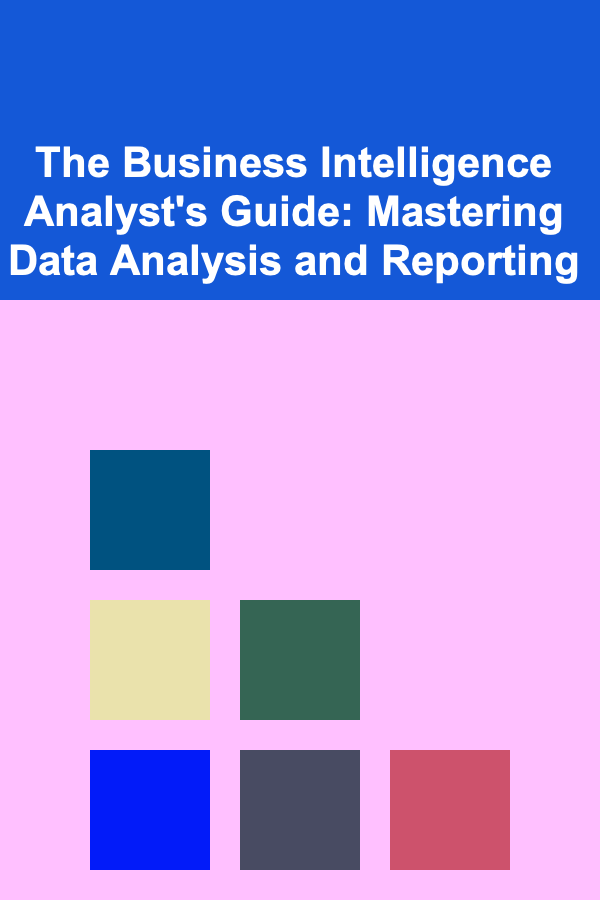
The Business Intelligence Analyst's Guide: Mastering Data Analysis and Reporting
ebook include PDF & Audio bundle (Micro Guide)
$12.99$11.99
Limited Time Offer! Order within the next:

Business Intelligence (BI) has become an essential aspect of the modern business landscape, empowering organizations to make data-driven decisions that improve performance, optimize processes, and foster innovation. As companies continue to generate vast amounts of data, the role of the Business Intelligence (BI) Analyst has grown increasingly important. BI Analysts are tasked with interpreting data, uncovering actionable insights, and presenting findings that guide strategic decisions.
In this guide, we'll dive deep into the skills, tools, and strategies you need to master data analysis and reporting as a BI Analyst. From understanding the core principles of BI to advanced techniques for data analysis and reporting, this actionable guide will help you elevate your skills and become an expert in BI analysis.
The Role of a Business Intelligence Analyst
Before we delve into the technical details, it's important to understand the primary responsibilities of a BI Analyst. At its core, a BI Analyst is responsible for transforming raw data into meaningful insights that can inform business decisions. This requires a mix of technical, analytical, and business skills.
Key Responsibilities:
- Data Collection and Preparation: Gathering data from various sources such as databases, spreadsheets, APIs, and external systems.
- Data Analysis: Using statistical and analytical techniques to identify trends, patterns, and insights within the data.
- Reporting: Creating dashboards, reports, and visualizations that present findings to stakeholders in an easy-to-understand format.
- Collaboration: Working closely with other departments, such as marketing, finance, and operations, to ensure that BI efforts are aligned with business objectives.
Now that we've outlined the role, let's explore the essential steps and skills for mastering data analysis and reporting.
Building a Strong Foundation in Data Analysis
To be an effective BI Analyst, you must first have a solid understanding of data analysis techniques. Data analysis is the process of inspecting, cleaning, and transforming data to uncover useful information. Here are the key areas you need to master:
a. Understanding Data Types and Structures
A BI Analyst needs to be familiar with different types of data and their structures. There are two primary categories:
- Structured Data: This type of data is organized in predefined formats such as tables (e.g., relational databases). Examples include sales data, customer information, and financial reports.
- Unstructured Data: Data that does not have a predefined structure, such as text files, images, social media posts, and emails. With the rise of big data, unstructured data has become increasingly important.
- Semi-Structured Data: This type of data doesn't conform to the traditional table format but has some level of organization, such as JSON or XML files.
Understanding these data structures is critical because different analysis techniques and tools are needed depending on the data type.
b. Data Cleaning and Preprocessing
Data cleaning is one of the most important steps in data analysis. Raw data is often messy, incomplete, or inconsistent. It's essential to clean and preprocess the data before analysis.
Key data cleaning tasks include:
- Removing duplicates: Identifying and eliminating duplicate records.
- Handling missing values: Addressing missing data points by using imputation methods or removing incomplete records.
- Standardizing formats: Ensuring that dates, currencies, and other fields follow consistent formats.
- Outlier detection: Identifying and dealing with outliers that could distort analysis results.
By addressing these issues, you ensure that the data is accurate and reliable for subsequent analysis.
c. Exploratory Data Analysis (EDA)
Exploratory Data Analysis (EDA) is the process of summarizing the main characteristics of the data before applying any complex analysis techniques. It helps to understand the data better and uncover potential trends or patterns. Common EDA techniques include:
- Descriptive statistics: Using measures such as mean, median, standard deviation, and range to understand the distribution of data.
- Data visualization: Visualizing data using charts like histograms, scatter plots, and box plots to identify patterns, trends, and anomalies.
- Correlation analysis: Identifying relationships between variables using correlation coefficients (e.g., Pearson correlation).
EDA is a crucial step because it helps guide the direction of more advanced analysis.
Mastering Data Analysis Techniques
Once you have cleaned and explored your data, it's time to move on to more advanced analysis techniques. This is where the real insights are uncovered, and BI Analysts can add significant value to the organization.
a. Statistical Analysis
Statistical methods allow you to identify relationships, trends, and anomalies in data. Common statistical techniques include:
- Regression analysis: Understanding the relationship between dependent and independent variables. This is especially useful for predicting future trends based on historical data.
- Hypothesis testing: Conducting tests (e.g., t-tests, chi-squared tests) to determine if a hypothesis about the data can be accepted or rejected.
- ANOVA (Analysis of Variance): Comparing multiple groups to see if they differ significantly in terms of a particular variable.
b. Predictive Analytics
Predictive analytics uses historical data to forecast future outcomes. This involves applying machine learning algorithms or statistical models to make predictions. Common techniques include:
- Linear regression: Predicting a continuous outcome based on one or more predictor variables.
- Decision trees: A tree-like model used to make decisions based on input variables.
- Time series forecasting: Analyzing time-ordered data (e.g., sales over time) to predict future values.
c. Prescriptive Analytics
While predictive analytics focuses on forecasting future outcomes, prescriptive analytics recommends actions that can optimize future outcomes. This often involves the use of optimization algorithms, simulations, and decision analysis. Examples include:
- Optimization models: Finding the best solution to a problem, such as minimizing costs or maximizing profits.
- Monte Carlo simulations: Running simulations to understand the range of possible outcomes and determine the best course of action.
Data Visualization and Reporting
As a BI Analyst, your role is not just about performing data analysis; you also need to communicate your findings effectively. This is where data visualization and reporting become critical.
a. Data Visualization Best Practices
Effective data visualization transforms complex data into clear, actionable insights. When creating visualizations, consider the following best practices:
- Choose the right chart type: Select the appropriate chart or graph to represent your data. For example, use line charts for trends over time, bar charts for comparisons, and pie charts for proportions.
- Simplify your visuals: Avoid clutter. Use color and design elements sparingly to draw attention to the most important insights.
- Use interactivity: Interactive dashboards allow users to explore the data themselves, drill down into details, and filter the data as needed.
- Tell a story: Your visualizations should not only present data but also tell a compelling story. Use clear titles, labels, and annotations to explain the insights.
b. Reporting
Once you've created your visualizations, the next step is to produce reports. A BI report should be structured and concise, presenting key findings and insights clearly. Key elements of a good BI report include:
- Executive summary: A brief overview of the most important insights.
- Methodology: A description of the analysis process and techniques used.
- Key findings: A detailed breakdown of the data insights, supported by visualizations.
- Recommendations: Actionable recommendations based on the analysis.
Reports can be presented through various mediums, including PowerPoint presentations, PDF documents, or interactive dashboards. The format should be chosen based on the needs of the audience.
Leveraging BI Tools
To perform data analysis and reporting efficiently, BI Analysts rely on a wide range of tools. Some of the most popular BI tools include:
- Tableau: A powerful data visualization tool known for its ability to create interactive dashboards and reports.
- Power BI: A Microsoft product that integrates seamlessly with other Microsoft tools. It's known for its user-friendliness and affordability.
- Qlik Sense: A self-service BI tool that emphasizes associative data exploration and interactive dashboards.
- Looker: A data exploration and analytics platform designed for data modeling and creating customizable reports.
- Google Data Studio: A free tool that integrates with Google Analytics, Google Ads, and other Google services to create interactive reports and dashboards.
These tools provide a wide range of capabilities, from data integration and cleaning to visualization and reporting. Selecting the right tool for your organization's needs is essential for optimizing the BI process.
Collaboration and Continuous Improvement
BI is not a one-man job; it requires collaboration with various departments and stakeholders. As a BI Analyst, you must work closely with marketing, finance, operations, and other departments to ensure that your analysis aligns with business objectives.
a. Communicating with Stakeholders
Effective communication is key to ensuring that your analysis leads to actionable insights. Here are some tips:
- Understand business goals: Regularly engage with business stakeholders to ensure that your analysis addresses their needs.
- Present findings clearly: Present your insights in a way that is understandable to non-technical stakeholders.
- Be proactive: Don't wait for requests. Proactively share insights that could help improve decision-making across the organization.
b. Continuous Learning and Adaptation
The world of data analysis is constantly evolving, with new techniques, tools, and best practices emerging regularly. To stay ahead of the curve, BI Analysts should commit to continuous learning. This includes attending industry conferences, taking online courses, and staying up to date with the latest trends in data analysis and BI tools.
Conclusion
Mastering data analysis and reporting as a Business Intelligence Analyst requires a blend of technical expertise, analytical thinking, and effective communication. By building a strong foundation in data analysis, mastering advanced techniques, and leveraging the right BI tools, you can provide valuable insights that drive business decisions and foster growth. Ultimately, your role as a BI Analyst is to turn raw data into actionable intelligence that leads to strategic success. With the strategies and tools outlined in this guide, you are well on your way to becoming an expert in the field of business intelligence.

How to Create a Cozy Atmosphere with Thanksgiving Floating Candles
Read More
How To Embrace a Zero-Waste Lifestyle
Read More
How to Make Money Online as a Music Producer: 10 Actionable Ideas
Read More
How to Soundproof Your Apartment Without Damaging the Walls
Read More
How to Soundproof Your Living Room for a Better Movie Experience
Read More
How to Practice Intonation and Rhythm
Read MoreOther Products

How to Create a Cozy Atmosphere with Thanksgiving Floating Candles
Read More
How To Embrace a Zero-Waste Lifestyle
Read More
How to Make Money Online as a Music Producer: 10 Actionable Ideas
Read More
How to Soundproof Your Apartment Without Damaging the Walls
Read More
How to Soundproof Your Living Room for a Better Movie Experience
Read More